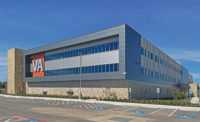U.S. Dept. of Veterans Affairs Lubbock Outpatient Clinic
Lubbock, Texas
Award
OWNER: Lubbock VA LLC
LEAD DESIGN FIRM: Hoefer Welker Architects
GENERAL CONTRACTOR: Jacobsen Construction Co.
CIVIL ENGINEER: Hugo Reed and Associates Inc.
STRUCTURAL ENGINEER: Bob D. Campbell and Co.
MEP ENGINEER: Smith & Boucher Inc.
SUBCONTRACTORS: A Plus Openings; A-1 Building Supply; Alamo Steel; American Direct; American Fence Co.; Andreola Terrazzo; Anson Hargrove & Associates; Arjo Inc.; Armstrong Plumbing; AVA Dek; B Double K Inc.; Budget Blinds of Lubbock; Collins Tile; Commercial Fireproofing; D&L Masonry; Diversified Interiors; Duo-Gard; E&E Irrigation; Hoj Engineering; Horizon Glass; Hugo Reed and Associates; JC Millwork; M&US Concrete; National Shielding; Otis Elevator Co.; Peterson Contractors; Rocky Duron and Associates; Roof’s Inc.; Seal-Co Inc.; Stryker; Temple Electric; Terracon; Unistrut; Utility Contractors of America; V-Tech; Wellborn Sign Co.; Yates Flooring; Zahn Paving
The COVID-19 pandemic escalated as contractors were midway through constructing the U.S. Dept. of Veterans Affairs Lubbock Outpatient Clinic.
This 127,000-sq-ft medical facility will serve 300,000 veterans in West Texas. The two-story clinic is more than three times larger than the facility it replaces and offers a physical therapy and occupational therapy area six times larger than the previous clinic. It also adds ophthalmology capabilities as well as a dental department.
An aggressive approach to COVID-19 protocols and other safety measures resulted in the project’s completion with zero recordable incidents or lost-time accidents, even after more than 19,000 worker hours on the job.
Project leadership sought the latest COVID-19 safety guidelines from local state and federal health authorities, and the project team placed as much emphasis on protecting each other from COVID-19 as they did in keeping each other safe from other jobsite risks.

Photo by Bob Greenspan
The team laid out safety expectations from the outset of the project, and workers were required to complete a project-specific orientation training that outlined all anticipated risks and mitigation strategies. Teams also had to attend weekly safety meetings, and workers were required to complete a task plan risk analysis every time they switched tasks throughout the day.




